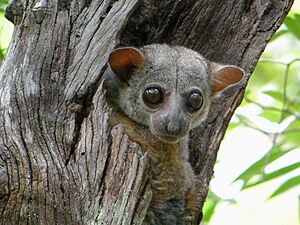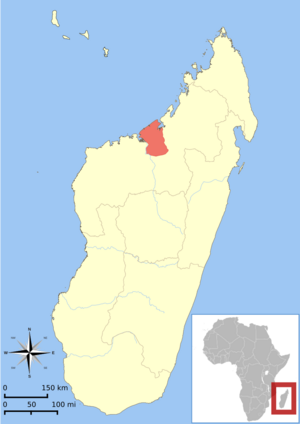Milne-Edwards' sportive lemur facts for kids
Quick facts for kids Milne-Edwards' sportive lemur |
|
|---|---|
 |
|
| Conservation status | |
| Scientific classification | |
 |
|
| Distribution of L. edwardsi | |
| Synonyms | |
|
The Milne-Edwards' sportive lemur (Lepilemur edwardsi) is a type of lemur found only in Madagascar. It is also called the Milne-Edwards' weasel lemur. These lemurs live in dry, warm forests. Sadly, their home is shrinking, which puts them in danger. Finding safe places to sleep is a big challenge for these lemurs. These spots protect them from predators and bad weather.
Contents
Where They Live
The Milne-Edwards' sportive lemurs live in the northern-eastern part of Madagascar. You can often find them in the Akanrafantsika National Park. They also live in the Mariarano Classified Forest.
These lemurs spend their time both in trees and on the ground. They prefer large-leaved trees in areas with an equatorial climate. They usually live within about one hectare (about 2.5 acres) of forest. Their habitat changes a lot between the rainy and dry seasons. This means the plants, temperature, and weather are very different.
Why Their Home is Shrinking
Forests in Madagascar are disappearing quickly, by almost 1% each year. This is a big problem for lemurs and other animals. Since the 1980s, countries like the US and France have helped Madagascar. They provide money and advice to protect the forests. This help includes plans for saving nature and developing farming methods that don't harm the environment.
The forests in Madagascar are also changing. They are becoming less dense near the coast and more dense inland. This shift affects animals like the Milne-Edwards' sportive lemurs that live in coastal areas.
How They Behave
Reproduction and Life Cycle
Milne-Edwards' sportive lemurs are seasonal breeders. This means they only mate during certain times of the year. Males and females are ready to mate from May to July. Their main breeding season lasts about two months each year.
Like other mammals, females are pregnant for about four to five months. They usually give birth around October. Giving birth during the rainy season is best for the mother. This is because there is plenty of food, which helps her produce milk for her baby. Females usually have only one baby each year. This low birth rate makes it harder for their population to grow when their habitat is being harmed by humans.
What They Eat
This type of sportive lemur eats only leaves. They are called folivores. They often have to compete with other animals for food. This means they sometimes have to eat lower-quality leaves.
Milne-Edwards' sportive lemurs usually travel in groups of two to five at night. They feed on the same trees together. They don't usually show aggression towards each other while eating. Studies show that how many lemurs are in a group depends on how much food is available. Males and females compete for food. However, they find it better to defend scarce food sources as a pair, even if it means feeding two mouths instead of one.
Social Life
These lemurs often live in spread-out pairs or small groups. They have a social system where one female might mate with several males.
However, Milne-Edwards' sportive lemurs also practice "duetting." This means a male and female pair sing together to care for their babies. Studies show that these pairs share sleeping and feeding spots when the female is pregnant. This means that while they compete for mates during breeding season, they form strong partnerships to raise their young. Males and females sing together equally. There is no difference in who starts the calls or leads the way. This suggests they live in an equal society.
Duetting is often used to defend their territory. But Milne-Edwards' sportive lemurs don't mark their territory in other ways. Males don't use scent glands, and they don't urinate to mark their land. However, some researchers have seen these lemurs bite the tree trunks where they sleep. This might be a way to recognize their sleeping spots. It could also be a small way to show ownership of their sleeping area.
In short, these pairs work together to defend their sleeping spots, especially when they have babies. But during breeding season, they compete for mates because pairs haven't formed yet.
How They Communicate
Milne-Edwards' sportive lemurs sing together at night. This duetting helps them avoid predators and protect their territory. It also helps them communicate when they are raising a baby. Duetting is an important way for pairs to talk to each other over long distances. One lemur starts a call, and the other responds. This teamwork helps them survive.
Duetting is common among birds and some primates that live in pairs and defend a territory together. Even though Milne-Edwards' sportive lemurs live in spread-out pairs, they still use these calls when raising a baby. They use duets more often to coordinate their activities at night, especially when they are moving around.
Researchers believe these lemurs evolved to use duetting for the same reasons as other pair-living species. This includes defending their territory together, protecting food, and caring for their young. These calls also help strengthen the bond between the male and female lemurs.
Health Concerns
Parasites
Milne-Edwards' sportive lemurs generally have fewer parasites compared to other mammals. Researchers have not found a difference in parasites between lemurs of different body sizes or health. This suggests that size and health don't affect how many parasites they carry. Parasites are more common during the wet season. It's also possible that very sick lemurs with many parasites die quickly, which could affect the data. Males tend to have more parasites than females, likely due to differences in hormone levels like testosterone.
Saving the Lemurs
Their Status
The Milne-Edwards' sportive lemur is currently listed as an endangered species. Their population is constantly shrinking. This is due to hunting in Madagascar and other human activities. These actions make their territory smaller and worsen their living conditions.
Why Their Numbers Are Falling
Their population has dropped by more than half in less than 30 years. We don't have exact numbers of how many lemurs are left. However, researchers are finding fewer and fewer lemurs in their habitats. This raises serious concerns about their population levels.
Hunting is a major reason for their decline. People in villages near Akanrafantsika often don't have enough food. This forces them to hunt wild animals like lemurs for survival. Many children in these areas are underweight due to poor nutrition. This situation pushes people to hunt lemurs to feed their families.
Losing Their Home
The Milne-Edwards' sportive lemur's home is currently threatened. Their forest habitat is being burned to create land for farm animals. It is also being cleared for mining projects or coal. The Rainforests in Madagascar are a big topic of discussion. The government has lost control over how quickly land is being cut down for use. They also struggle to collect rent for the land being used.
Many animals and plants rely on Madagascar's forests. The island has amazing biodiversity, but it also has a lot of poverty. This makes the forests even more likely to be destroyed. It is very important to have a strong plan to protect these rare species. Madagascar is also home to the lemuriformes infraorder, which includes about a quarter of all primate species.
What is Being Done to Help
Efforts to protect Madagascar's natural resources began a long time ago. In 1896, France took control of Madagascar as a colony. They aimed to protect the forests from human-made fires, while also using the timber. Research shows that before humans arrived, Madagascar was completely covered in forests. The first national park in Madagascar, the Botanical and Zoological Garden of Tsimbazaza, was created by France in 1925. Soon after, ten more national parks were set up. Their goal was to control logging and clearing forests for farming.
As Madagascar's economy got worse, the government allowed open access to its forests in the early 1980s. Investors from outside Madagascar started cutting down forests both inside and outside protected areas. In 1984, the USAID helped by donating money to stop deforestation. Madagascar's laws and policies changed a lot starting in 1985, mostly because of these donors. In 1988, the government signed Madagascar's National Environment Action Plan (NEAP). This plan aimed to protect Madagascar's forests. In 2003, then-president Marc Ravalomanana announced a plan to triple the amount of protected land in Madagascar. It took 12 years to reach this goal, with help from many organizations.
In 2009, the USAID looked at the conservation efforts over the past 25 years. Their results showed that these efforts were not strong enough, or the plans were not followed. The situation of Madagascar's forests has actually gotten worse since 1985. There is a clear conflict between protecting the forests and the needs of the people. Protecting the forest can make it harder for people to produce food and earn money. Poverty is often linked to conservation efforts when there isn't enough help from charities or the government. As the population grows, more people want to use protected land. This is often the only way for locals to get food or an income. This means that help for conservation is more needed than ever before.
The Milne-Edwards' sportive lemurs are listed under Appendix I of the Convention on International Trade in Endangered Species of Wild Fauna and Flora (CITES). To help them, we need many types of land management. We also need a strong authority to watch over the situation and enforce rules to protect this species.


